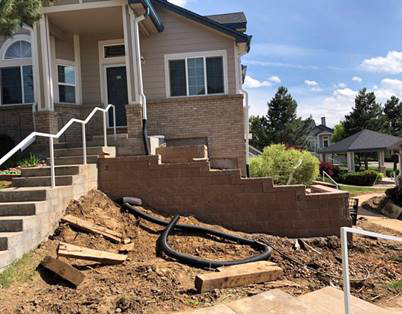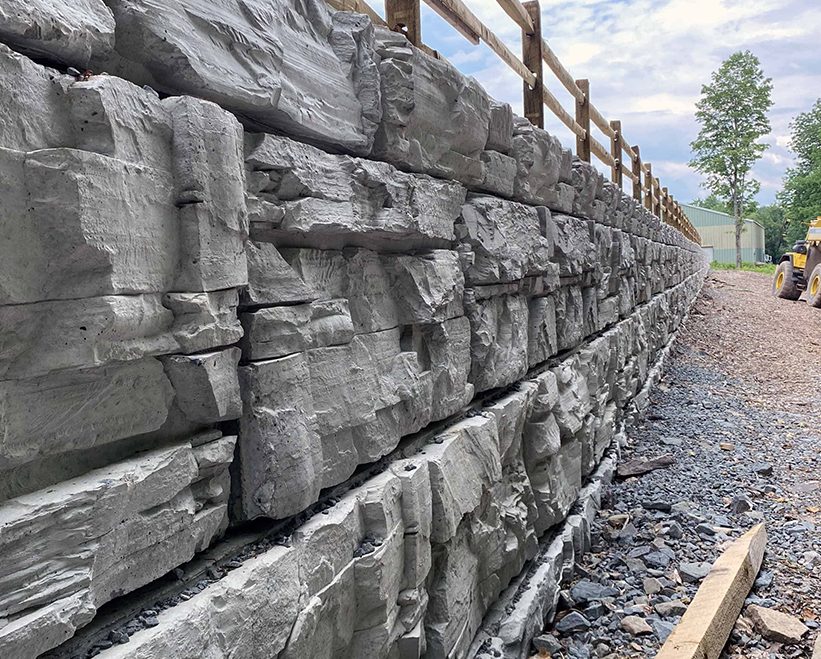Secret Factors To Consider for Building Effective Retaining Walls in Your Lawn
When you're thinking about building a retaining wall surface in your yard, it's important to believe concerning several key factors. The wall's objective, the materials you'll utilize, and the details dirt conditions can all affect its performance and longevity.
Recognizing the Function of Your Retaining Wall
When you think of developing a keeping wall surface, consider its major purpose: supporting soil and stopping erosion. Retaining walls offer essential assistance for sloped landscapes, helping to keep dirt integrity. You'll discover they're essential in locations where water drainage could otherwise remove soil, leading to pricey repair services and landscape damage.
By keeping back planet, these walls create level surfaces for yards, patio areas, or pathways. This not only improves your backyard's looks yet also advertises better water drainage, minimizing water pooling in undesirable areas. If you're handling steep inclines, a well-constructed retaining wall surface can stop landslides, guaranteeing safety for you and your property.
Ultimately, comprehending the function of your retaining wall will lead your layout decisions and help you create a functional, resilient structure that satisfies your demands. So, take a minute to examine your landscape; it'll repay in the lengthy run.
Picking the Right Materials
When picking products for your retaining wall, you'll desire to think about resilience, aesthetic appeals, and cost. Each aspect plays an important duty in ensuring your wall surface stands the test of time while looking great and fitting your budget. Let's explore how to make the very best selections for your job.
Material Sturdiness Aspects
Choosing the best materials is important for the long life and efficiency of your retaining wall, considering that their sturdiness directly influences the wall surface's capability to stand up to environmental tensions. Start by considering your regional climate; products like concrete and rock resist wetness and temperature changes well. If you stay in an area vulnerable to hefty rains, select materials with good drain residential or commercial properties, like crushed rock or porous blocks, to prevent water buildup.
Furthermore, think of the soil problems on your residential or commercial property. Some products perform far better in details soil types, so it's crucial to match them accordingly. Finally, know prospective wear from pests or disintegration. Selecting long lasting products guarantees your retaining wall stands strong, securing your yard for many years to find.
Visual Layout Choices
Sturdy products not just assure your retaining wall's architectural stability but also play a vital function in its aesthetic charm. When choosing the ideal materials, assume concerning exactly how they complement your landscape. All-natural stone provides a timeless, rustic appearance, while concrete blocks can supply a streamlined, modern-day surface. You might likewise think about making use of hardwood for a cozy, natural feeling. Color and texture issue, also; choose tones that integrate with your home and garden. Do not ignore the wall's form-- curved walls can produce a softer appearance, while straight lines can really feel much more organized. By meticulously picking products that line up with your visual vision, you'll boost your outdoor room while guaranteeing your wall stands strong against the components.
Cost-Effectiveness Analysis
Choosing the ideal materials for your retaining wall isn't almost appearances; it's also crucial for your budget plan. When picking materials, consider both ahead of time costs and lasting longevity. Concrete blocks could be costlier initially, however their longevity can conserve you money on repairs. On the various other hand, lumber can be much more budget-friendly yet may call for substitute quicker.
Do not fail to remember to factor in maintenance prices also (OKC Precision Retaining Walls). Some materials, like all-natural stone, can include elegance and need much less maintenance, while others might require routine therapies
Inevitably, consider the advantages and disadvantages of each choice versus your budget and the wall surface's desired function. Spending wisely in materials currently can protect against expensive issues later on. Choose materials that stabilize price and performance efficiently.
Examining Soil Problems and Drainage
As you start your job, examining dirt conditions and drain is important for the success of your retaining wall surface. Beginning by taking a look at the kind of soil in your backyard. Sandy dirt drains well however does not have security, while clay dirt can maintain moisture, causing push on your wall surface. Check the dirt's moisture material by digging a tiny opening and observing exactly how quickly it dries.
Next, evaluate the incline of your lawn. If water naturally moves towards your wall surface, you'll require to implement a drain solution to stop disintegration and stress build-up. Think about setting up perforated pipelines or gravel backfill behind the wall surface to promote water drainage.
Finally, observe any close-by trees or vegetation; their roots can impact soil stability. By understanding your soil conditions and carrying out proper drain, you'll develop a strong foundation for your retaining wall that stands the test of time.
Complying With Local Building Ordinance
Before you begin constructing your retaining wall surface, you require to research study local laws to guarantee additional reading compliance. It's important to comprehend what permits you must get, as this can save you from costly penalties or needing to redo your work. Taking these actions seriously will aid you develop a risk-free and reliable framework.
Study Local Regulations
Recognizing local guidelines is necessary when preparing your retaining wall job, especially since building codes can vary substantially by area. Look for guidelines on wall surface elevation, materials, water drainage systems, and architectural stability. informative post By doing your research study upfront, you can ensure your retaining wall satisfies all required codes and blends effortlessly into your lawn.
Acquire Necessary Permits
Once you've researched local regulations, the following step is to acquire the essential permits for your retaining wall task. This process guarantees your wall surface abides by building ordinance and security requirements. Connect to your neighborhood building authority to discover what permits you need. They may require certain plans or design evaluations, specifically for larger walls. Be prepared to submit thorough illustrations, including dimensions and products. Don't neglect to inspect if your project affects water drainage or surrounding residential or commercial properties, as these aspects might call for extra authorizations. Safeguarding the appropriate approvals can save you from costly penalties or having to dismantle your wall later on. Keep in mind, adhering to the rules now will cause a smoother construction experience.

Planning the Design and Aesthetic Appeal
As you start intending the layout and looks of your retaining wall surface, think about how it will balance with the bordering landscape. Consider the materials you'll use-- rock, block, or concrete-- and how they'll match your home's architecture and the natural environments in your yard. Select colors and textures that blend seamlessly with existing attributes like patios, pathways, or yards.
Following, imagine the wall surface's shape and elevation. Rounded walls can soften an inflexible landscape, while straight lines may communicate a more modern-day appearance. Do not fail to remember to include plants and greenery around the wall for a natural touch; this can boost its charm and incorporate it into the atmosphere.
Finally, keep in mind performance. Your layout should not only be aesthetically pleasing but additionally offer its function effectively. By attentively intending these elements, you'll create a maintaining wall surface that improves your backyard's beauty while fulfilling its structural duty.
Computing Height and Density Demands
To develop a sturdy retaining wall surface, you need to properly compute its height and thickness requirements based upon the soil problems and the height of the slope it will sustain. Start by examining the incline's angle and the kind of soil, as various soils put in varying amounts of stress.
For walls over four feet high, take into consideration a thickness of at the very least 12 inches. If the wall surface is taller, increase the thickness proportionally to keep security.
Following, determine the elevation of the wall by measuring the vertical range it requires to retain. For every foot of elevation, from this source you should usually prepare for a thickness of one-third of the wall's elevation.
Always keep in mind to make up additional elements like drain and backfill, which can influence your wall surface's style. Appropriate computations now ensure your retaining wall surface stands strong and lasts for many years ahead.
Upkeep and Long Life Considerations
While keeping your retaining wall could feel like a low priority, overlooking it can result in substantial issues with time. Routine examinations are essential; look for cracks, protrudes, or any kind of signs of water damages. Dealing with these troubles early can save you from expensive repair services later on.
Watch on water drainage systems, as well. Blocked drains can cause water to develop, exerting pressure on your wall and jeopardizing its security. Clear debris and guarantee correct flow to maintain durability.
You might also intend to reflect on sealing your wall to safeguard it from wetness and weathering. Depending upon the product, this might require reapplication every couple of years.
Last but not least, landscape design around your wall can support its stability. Prevent planting large trees close by, as their origins can threaten the foundation. With aggressive maintenance, your retaining wall can offer you well for years to find.

Regularly Asked Questions
Can I Build a Retaining Wall by Myself, or Should I Hire a Professional?
You can definitely develop a retaining wall yourself if you have the right tools and knowledge. Nonetheless, employing an expert guarantees it's done appropriately, specifically for larger or more complex structures. Consider your skill degree before making a decision.
What Are the A Lot Of Usual Blunders Made When Building Retaining Walls?
When building retaining walls, you might ignore appropriate water drainage, miss making use of the ideal products, or disregard support. These typical blunders can bring about architectural failing, so take your time and plan thoroughly to prevent problems.
Exactly how Do I Know if My Retaining Wall Needs Support?
You'll recognize your retaining wall requires reinforcement if you see splits, leaning, or protruding. Look for water pooling behind it or dirt erosion near the base. Address these indicators quickly to stop more damage.
What Plants Appropriate for Landscaping Around a Retaining Wall?
When landscape design around a keeping wall, consider utilizing low-maintenance plants like succulents, ornamental yards, or slipping ground covers - OKC Precision Retaining Walls. They'll flourish in those conditions and include beauty while protecting against soil disintegration around your wall surface
How Can I Avoid Erosion Around My Retaining Wall?
To avoid disintegration around your retaining wall surface, you can plant ground cover, usage mulch, and mount water drainage systems. Regularly inspect for water accumulation and change landscape design to redirect runoff far from the wall.